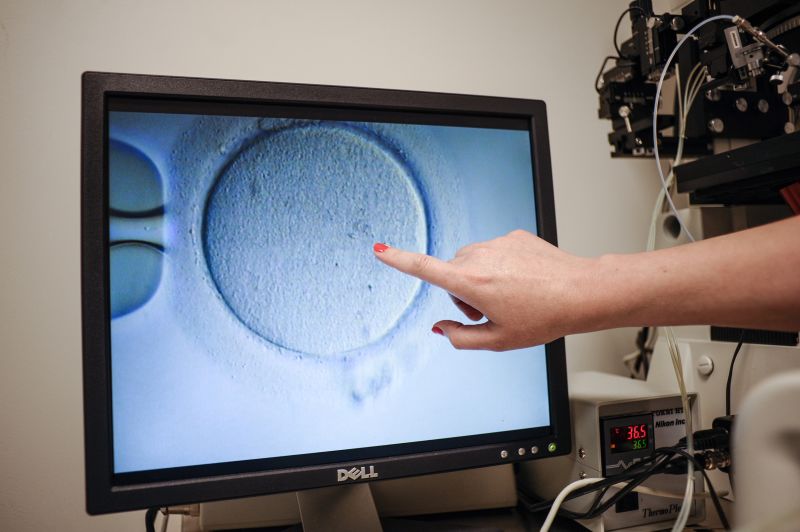
CNN —
Pregnancies from in vitro fertilization utilizing frozen embryos seem to be linked to an elevated risk of complications related to high blood strain, or hypertensive problems, in contrast with when recent embryos are used or when a pregnancy is conceived naturally.
That’s in accordance to a study revealed Monday in the American Coronary heart Affiliation journal Hypertension, which included information on greater than 4.5 million pregnancies, spanning virtually three many years, throughout three European nations: Denmark, Norway and Sweden.
The risk of pregnancy complications related to high blood strain was higher after the switch of frozen embryos in contrast with naturally conceived pregnancies, and the risk following recent embryo transfers was comparable to that of naturally conceived pregnancies, the information reveals.
Extra analysis is required to decide whether or not comparable findings would emerge in the US.
The researchers – from the Norwegian College of Science and Expertise and different establishments in Europe – analyzed medical start registries from Denmark that had been dated between 1994 and 2014, from Norway dated 1984 to 2015, and from Sweden dated 1985 to 2015. The registries included about 4.4 million pregnancies naturally conceived, 78,300 pregnancies that used recent embryo switch and 18,037 pregnancies from frozen embryo switch.
The researchers in contrast odds of hypertensive problems throughout pregnancy throughout the teams and located that the unadjusted risk of such problems was 7.4% after frozen embryo switch, 5.9% after recent embryo switch and 4.3% after pure conception. The information additionally confirmed that pregnancies from frozen and recent embryo switch had been extra regularly preterm – 6.6% of the frozen and eight.1% of the recent, respectively – in contrast with naturally conceived pregnancies, at 5%.
“Frozen embryo transfers at the moment are more and more widespread everywhere in the world, and in the previous couple of years, some docs have begun skipping recent embryo switch to routinely freeze all embryos of their medical apply, the so-called ‘freeze-all’ method,” lead study writer Dr. Sindre H. Petersen, a Ph.D. fellow on the Norwegian College of Science and Expertise in Trondheim, Norway, stated in a information launch Monday.
“In abstract, though most IVF pregnancies are wholesome and uncomplicated,” he stated, “this evaluation discovered that the risk of high blood strain in pregnancy was considerably higher after frozen embryo switch in contrast to pregnancies from recent embryo switch or pure conception.”
Petersen added, “Our outcomes spotlight that cautious consideration of all advantages and potential dangers is required earlier than freezing all embryos as a routine in medical apply.”
The findings are “in settlement with earlier population-level research” displaying a higher risk of hypertensive problems throughout pregnancy after frozen embryo switch, the researchers wrote of their study.
Final yr, a big study out of France offered on the on-line annual assembly of the European Society of Human Replica and Embryology additionally discovered a higher risk of pre-eclampsia and hypertension in pregnancies derived from frozen-thawed embryos – and the risk was discovered to be better when the uterus was ready for implantation with hormone alternative therapies.
“The affiliation between frozen embryo cycles and hypertensive illness in pregnancy has been recognized for some time, and there’s nonetheless at present an energetic debate across the professionals and cons of ‘Freeze all for all?’ amongst fertility docs,” Dr. Ying Cheong, professor of reproductive medication on the College of Southampton, stated in a assertion distributed by the UK-based Science Media Centre in July. She was not concerned in both study.
“There are two essential factors to take house right here, firstly, while frozen embryo switch know-how has remodeled reproductive medication, FET should solely be carried out the place clinically acceptable and secondly, clinicians and scientists want to begin becoming a member of the dots between what occurs at early growth and later at start and past, a analysis space, for my part, that’s nonetheless poorly supported and studied,” Cheong stated.
The brand new study didn’t consider what might be driving this affiliation between frozen embryo transfers and high blood strain dangers, however some IVF docs query whether or not it’s actually recent vs. frozen.
“There’s one factor that isn’t clear: is it from the precise process of freezing the embryo or is it from the protocol used? Most IVF docs imagine from latest research and proof that it’s really the treatment protocol, not the IVF process,” Dr. Aimee Eyvazzadeh, a San Francisco-based reproductive endocrinologist, who was not concerned within the new study, wrote in an e mail to CNN on Monday.
“There are alternative ways to put together a uterus for switch,” she stated. One protocol entails a corpus luteum cyst, a fluid-filled mass that varieties within the ovaries and performs an essential function throughout pregnancy, because the corpus luteum produces the hormone progesterone that’s wanted throughout pregnancy. One other protocol depends on medicines to mimic ovulation.
“Research present that it’s the shortage of corpus luteum that will increase the risk and that is probably why a frozen switch could have a higher risk of pre-eclampsia,” Eyvazzadeh wrote.
General, the brand new study is “essential” for “anybody taking care of pregnant individuals after IVF,” she wrote. “Everybody taking care of pregnant individuals after IVF ought to pay extraordinarily shut consideration to this study. An increasing number of research are displaying what IVF docs already know and that’s that IVF after frozen embryo switch can enhance risk of pre-eclampsia.”




